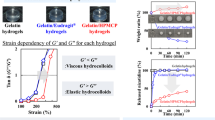Abstract
The swelling, permeation, and release characteristics for benzoic acid, caffeine, propranolol hydrochloride, and diclofenac sodium in crosslinked poly(2-hydroxyethyl methacrylate) (PHEMA) hydrogels were examined. Increasing polymer crosslinking density resulted in decreases in the degree of swelling, drug loading, the diffusivity of solute in the hydrogels, and in the rate of drug release. Diclofenac sodium led to an abnormally large degree of swelling as the maximum value is given as 6.5, while the highest for the other three was 1.07. That the logarithmic drug diffusivity was proportional to the reciprocal of hydration indicates that the free volume theory accounts for the transport of solute in the gels. Increasing the concentration resulted in increases in the diffusivities, solubilities, and permeabilities of the solutes in the hydrogels. The drug release kinetics from most wet hydrogel samples can be well-fitted by a Fickian diffusion model. Near zero-order release is observed only for dry samples with caffeine of low loading.
Similar content being viewed by others
References
S. H. Gehrke and P. I. Lee, in P. Tyle, Ed.,Specialised Drug Delivery Systems, Marcel Dekker, New York, 333–392, 1990.
E. H. Schacht, in J. M. Anderson and S. W. Kim, Eds.,Recent Advances in Drug Delivery Systems, Plenum Press, New York, 259–278, 1984.
B. D. Ratner and A. S. Hoffman, in J. D. Andrade, Ed.,Hydrogels for Medical and Related Applications, ACS Symp. Ser. No.31, American Chemical Society, Washington, DC,1–36, 1976.
N. A. Peppas, Ed.,Hydrogels in Medicine and Pharmacy, Vols.I–III, CRC Press, Boca Raton, FL, 1986-7.
R. W. Korsmeyer and N. A. Pappas, in T. J. Roseman and S. Z. Mansdorf, Eds.,Controlled Release Delivery Systems, Marcel Dekker, New York, 77–90, 1983.
P. I. Lee,J. Controll. Release,2, 277 (1985),
N. A. Pappas, H. J. Moynihan and L. M. Lucht,J. Biomed. Mater. Res.,19, 397 (1985).
N. A. Peppas and B. D. Barr-Howell, in N. A. Peppas, Ed.,Hydrogels in Medicine and Pharmacy, Vols. I. CRC Press, Boca Raton, FL, 27–56, 1986.
J. Crank,The Mathematics of Diffusion, Oxford University Press, London, 1975.
J. Crank and G. S. Park, Eds.,Diffusion in Polymers, Academic Press, New York, 1968.
C. E. Rogers, in D. Fox, M. M. Labes and A. Weissberger, Eds.,Physical and Chemistry of the Organic Solid State, Vol II, Interscience, New York, 509–635, 1965.
J.-N. Chang,Diffusion and Release of Drugs in PHEMA Hydrogels, MS Thesis. Yuan-Ze Inst. Tech., Taiwan. R.O.C., 1992.
K. A. Smith, C. K. Colton, E. W. Merrill and L. B. Evans,Chem. Eng. Progr. Symp. Ser.,64, 45 (1968).
C. K. Colton,Permeability and Transport Studies in Batch and Flow Dialyzers with Applications to Hemodialysis, Ph.D. Dissertation, M. I. T., Mass., U.S.A., 1969.
K. Tojo, Y. Sun, M. M. Ghannam and Y. W. Chien,AIChE J.,31, 741 (1985).
K. Tojo, J. A. Masi and Y. W. Chien,Ind. Eng. Chem. Fund.,24, 368 (1985).
J.-L. Lin. J.-W. Huang and Y.-M. Sun,Proc. Symp. Transport Phenomena and Applications, Taipei, R.O.C., 59 (1992).
D. E. Gregonis, C. M. Chen and J. D. Andrade, in J. D. Andrade, Ed.,Hydrogels for Medical and Related Applications, ACS Symp. Ser. No.31, American Chemical Society, Washington, DC, 88–104, 1976.
W. E. Roorda, J. A. Bouwstra, M. A. de Vries and H. E. Junginger,Pharm. Res.,5, 722 (1988)
H. Stutz, K.-H. Illers and J. Mertes,J. Polyms, Sci., Polym. Phys. Ed.,28, 1483 (1990).
H. Yasuda, C. E. Lamaze and L. D. Ikenberry,Markomol. Chem.,118, 19 (1968).
H. Yasuda, L. D. Ikenberry and C. E. Lamaze,Markomol. Chem.,125, 108 (1969).
L. Yean, C. Bunel and J.-P. Vairon,Markomol. Chem.,191, 1119 (1990).
R. W. Baker and H. K. Lonsdale, in A. C. Tanquary and R. E. Lacey, Eds.,Controlled Release of Biologically Active Agents, Plenum Press, New York, 15–71, 1974.
W. R. Good, in R. Kostelnik, Ed.,Polymeric Delivery Systems, Gordon and Breach, New York, 139–153, 1976.
P. I. Lee, in P. I. Lee and W. R. Good, Eds.,Controlled Release Technology: Pharmaceutical Applications, ACS Symp. Ser. No.348, American Chemical Society, Washington, DC, 71–83, 1987.
Author information
Authors and Affiliations
Rights and permissions
About this article
Cite this article
Sun, YM., Chang, JN. Solute transport in poly(2-hydroxyethyl methacrylate) hydrogel membranes. J Polym Res 2, 71–82 (1995). https://doi.org/10.1007/BF01493206
Issue Date:
DOI: https://doi.org/10.1007/BF01493206




